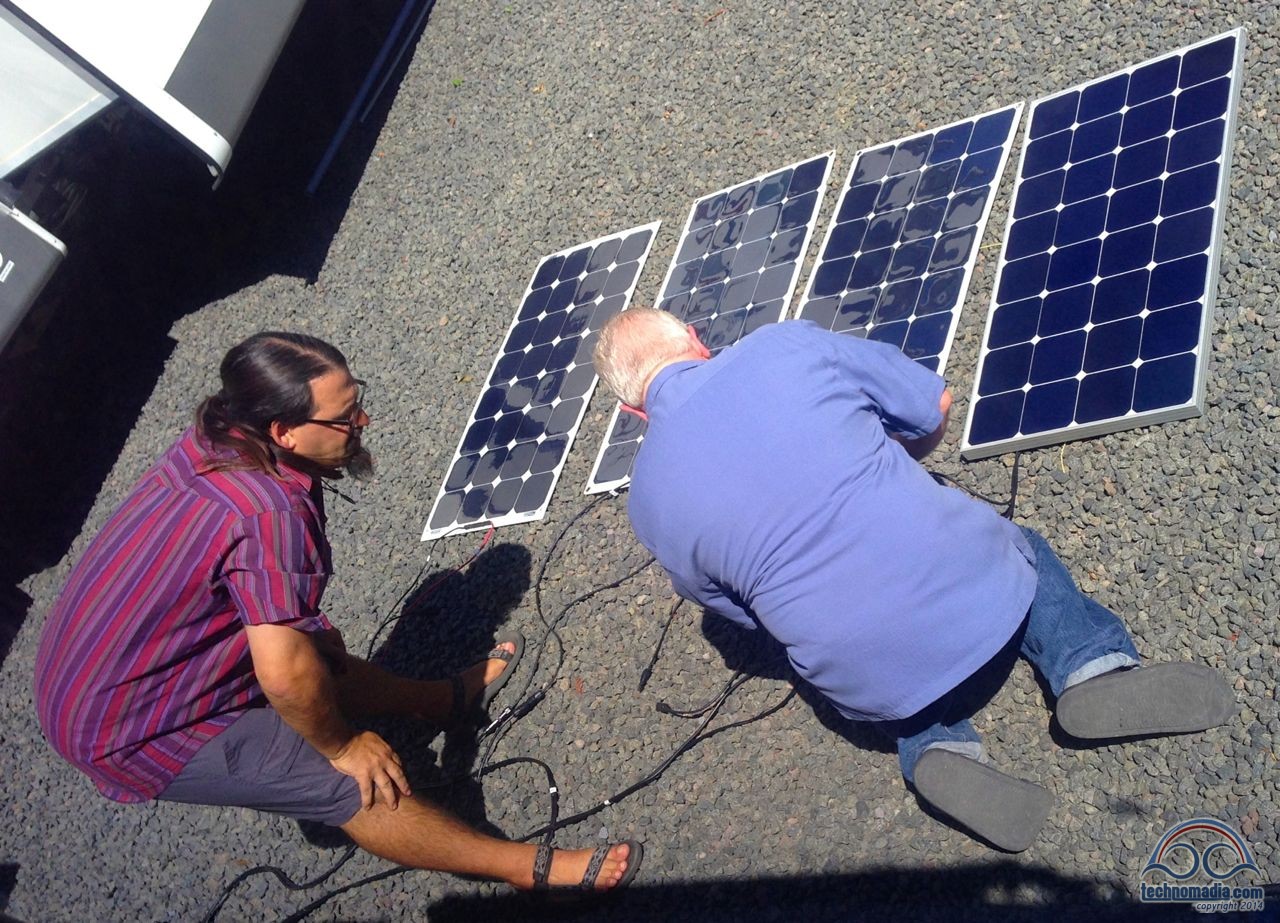
This is the second post in our series researching adding solar power to our bus. For an introduction to the project, click here. And for an index to all the articles in the series, click here.
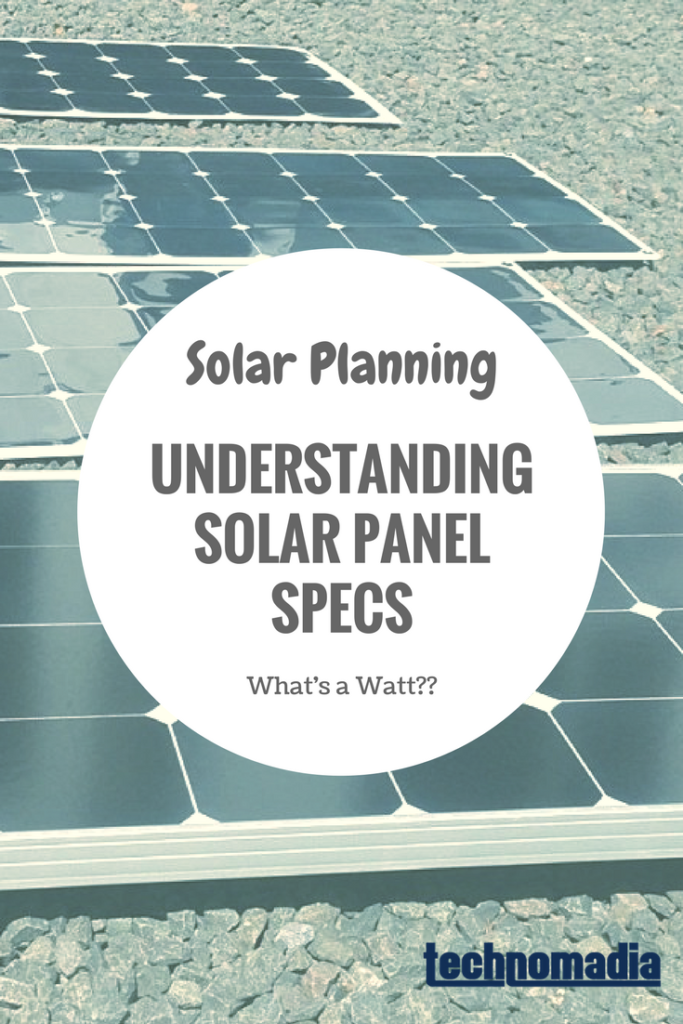 Before I dive into any geek project or major purchase, I like to do my homework and learn as much about the underlying technology and various options as possible.
Before I dive into any geek project or major purchase, I like to do my homework and learn as much about the underlying technology and various options as possible.
I actually read manuals and spec sheets for fun. And a big juicy technical white paper that dives into the engineering details can keep me up all night excitedly turning pages.
Understandably – not everyone enjoys curling up with a tech manual, spreadsheet, and 30+ web tabs open to cross-compare products.
And unfortunately, spec sheets are not written for average readers to easily comprehend. They turn into a sea of numbers that are at best confusing, and are often actually misleading once marketing departments gets involved trying to turn raw specifications into a reason to “buy now”.
Solar panel specifications can be especially hard to understand and compare. What numbers matter? Is a bigger number better? Smaller?
How can two different panels be compared?
Will you ever really get 100 watts out of a 100W panel?
What’s a Watt, Anyway?
Everyone has heard of a “watt”, but not many people have a solid grasp of what a watt actually is.
The “watt” is the standard unit used to measure power, named after Scottish inventor James Watt who developed the concept of “horsepower” for comparing the capability of steam engines back in the late 18th century.
To put a watt into context – 1 horsepower is defined as 746 watts, the average output of a typical draft horse. A puny human can sustain an output of around 75 watts (1/10 a horse!) over the course of a full workday.
The power required to run electrical devices is also measured in watts, as is the power produced by generators and solar panels. Thinking of things in watts is the best way to compare power production, and to balance it with power needs.
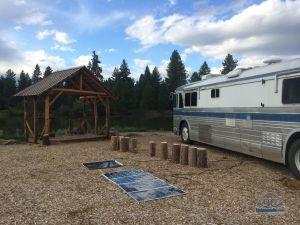
Solar panels come in a range of physical sizes and wattages – but the sizes most commonly used on RV’s range from 40W to 200W. Using 100 watt panels is particularly common, and by combining multiple panels on a roof larger systems can be built.
The largest RV solar installation we have seen managed to squeeze around twenty 100W panels on a roof for a 2000+ watt system. But most RV solar systems tend to be 500W or less. Often much much less.
A typical RV generator on the other hand might range from a 2000W portable (like the popular Honda EU2000) to a big 7500W built in unit, to even larger 15,000W generators in big Prevost-stlye buses.
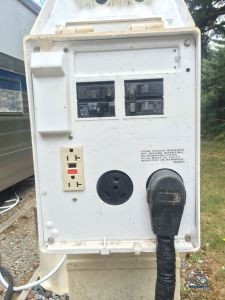
On shore power – a 15-amp standard wall outlet can provide 1,800W to an RV, a 30-amp RV plug 3,600W, and a 50-amp RV shore power outlet can provide a whopping 12,000W via two independent 50A legs. This is what it takes to run multiple standard RV air conditioning units at once – each RV AC can easily draw over 1,500W while operating.
It takes an extreme solar system to even begin to hope to keep up with running an air conditioner, and it would take way more 100W solar panels than any RV roof could ever hold to equal the output of even a mid-range portable Honda generator.
When you start looking at the wattages, it hardly seems worth the effort to go solar – and for many usage scenarios it isn’t.
The advantage solar has is that it is clean, quiet, passive, and as long as the sun is shining there is no fuel tank to run dry.
Understanding Solar Spec Sheets
You’ll see a lot of numbers and details on solar panel specification sheets. Here’s what they mean, and how to calculate and compare the numbers that might not be so obvious.
- Power (Pmax) – This is the maximum wattage the panel is capable of producing, under absolutely ideal conditions. More wattage is always a good thing, all things being equal.
-
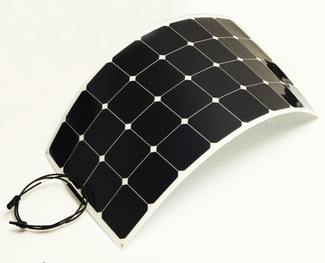
A flexible panel made up of 32 individual solar cells. Cell Type & Efficiency – Solar panels are made up of solar cells wired together. The cells are where the magic happens – converting sunlight into electricity. A key point of comparison is just how efficient this conversion process is. The very best commercially available solar cells are still less than 25% efficient at this process, with 15% to 18% efficiency being much more common. In general monocrystalline cells are more efficient than polycrystalline cells, and they are both much more efficient than amorphous silicon thin film cells. (For more on efficiency, see the section below.)
- Dimensions: Length / Width / Depth / Weight / Flexibility – For installation onto an RV roof, the physical dimensions of a panel become critically important. Narrow panels in particular allow for more flexible roof layouts, working around roof vents and air conditioners. Thin and flexible panels are much lighter weight and have an advantage that they can be mounted directly to a roof, but the downside is that without an airspace underneath they can get a lot hotter. Hot panels are less efficient, and also heat up an RV interior more too.
- Watts / Square Meter – If you have limited surface area for panels, more efficient cells can cram a lot more wattage onto your roof. To compare panels in this way, multiply the length and width to get the area and divide the panel wattage by this value. The more watts per square meter, the better.
-
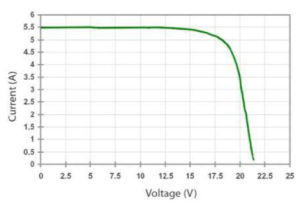
The “Maximum Power Point” is at the knee of this curve, Voc is at the bottom right, and Isc is at the top left. Voltage at Maximum Power Point (Vmpp) & Current at Maximum Power Point (Impp) – These are the key numbers for any solar panel, and describe the electrical point at which the panel is operating at peak efficiency – the maximum power point. Voltage times current gives you wattage, so (Vmpp x Impp) should always give you Pmax. When you wire different panels in parallel, you should try to match the Vmpp so that they work well together. And when you wire panels in series, try to match the Impp.
- Open Circuit Voltage (Voc) – If you test a solar panel that is not hooked up to anything other than the sun with a voltmeter, this is what you should read. It will always be higher than Vmpp – this is the maximum voltage the panel can ever produce. You need to make sure that the Voc of you solar panels is within the compatible input range of your solar charge controller – as long as it is, higher voltages can give more headroom above your battery voltage to help with charging.
- Short Circuit Current (Isc) – This how much current will flow if you touch the two wires coming out of the solar panel together, causing a short circuit. This is primarily important to ensure that you are using large enough wires and fuses for a safe installation.
- Warranty – A key number that should give you an idea how long the manufacturer expects the panels to perform up to specifications. Some rigid solar panels have warranties to produce 80% of rated power (under standard test conditions) for up to 30 years, but most flexible panels have much shorter warranties. Once a flexible panel has been glued to a roof, you will have a potentially hard time removing it intact for a warranty claim regardless. And of course a warranty is only useful if the company manages to stay in business long enough to honor it.
- Price Range & Price / Watt – All things being equal, cheaper is better. But there are always tradeoffs to be made. Solar panels currently range from slightly under $1/watt up to over $10/watt. Prices that seem too good to be true often are, so do look for reputable suppliers.
The key specifications to worry about for RV usage is the overall panel power, the price per watt, the watts per square meter, and the overall dimensions to make sure that the panels will fit where you have room for them.
“Standard Test Conditions” You Will Never See
Odds are you will never ever get 100W of power out of a 100W panel on your RV roof.
And in reality, seeing 75W or 80W is actually going to be a more common noon-time maximum.
Solar panels are rated to perform according to their official specifications under “standard test conditions” (aka “STC”) – a condition that can be created in a lab to allow for easy measurement and comparison. The defined STC for solar is a panel pointed directly at a bright sun with 1000W of solar energy landing per square meter, with the panel kept at 25 degrees celsius (77 degrees fahrenheit) with an atmospheric mass (a number that refers to the amount of atmosphere between the panel and the sun) of 1.5 overhead.
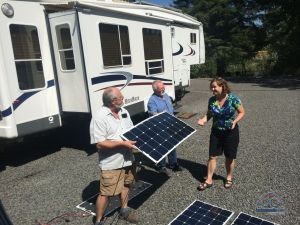 These are laboratory conditions – and the specs do not tell you how well a panel will work in actual real world situations.
These are laboratory conditions – and the specs do not tell you how well a panel will work in actual real world situations.
A lot can impact the power a panel puts out – for example when the panel is not pointed directly at the sun, or the panel is hot, or scuffed, or shaded, or just plain dirty.
Heat in particular is a killer – the warmer a solar panel gets, the less power it puts out. Without any air space underneath to allow for cooling, heat becomes one of the prime concerns with using flexible panels mounted directly to an RV roof.
Angle is another big impact on power output – RV solar panels tend to be mounted flat, and even systems with rigid panels and panel tilting props tend to never end up with tilted panels without some fancy mechanisms to do it automatically. We had the capability to tilt the panels on both our prior solar setups on our trailers, but we rarely bothered because it was such a hassle.
Shade and dirt are always a concern – because even a tiny corner of a panel blocked from getting sunlight could end up diminishing the output of the entire panel.
And finally – time of day matters. There are only a few hours each day to either side of solar noon when a panel will produce the bulk of its daily output.
Understanding Solar Efficiency
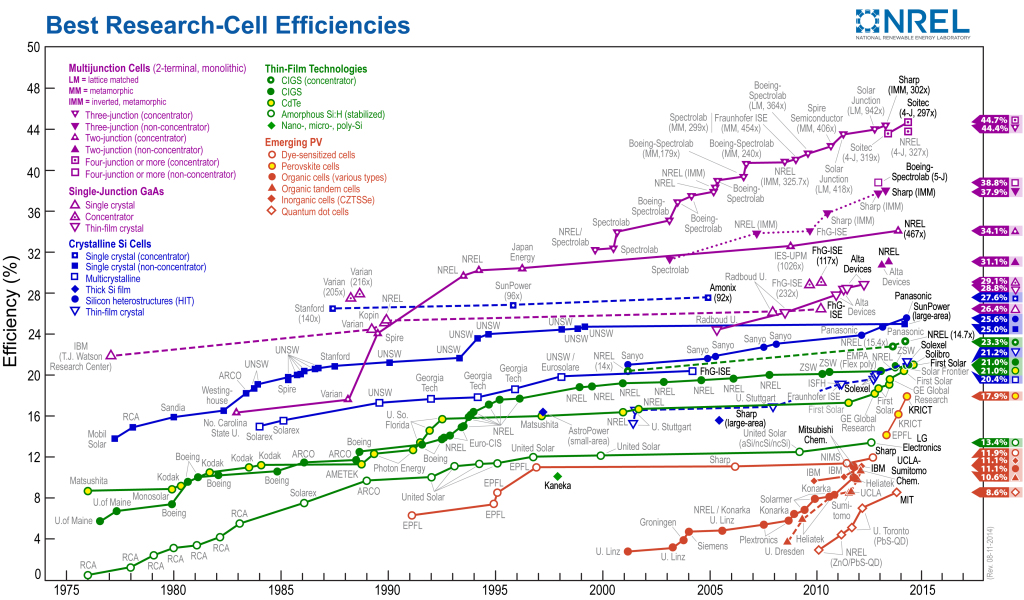
If 1000W of solar energy is landing on a square meter surface, it is theoretically possible to convert 86% of that energy into electricity.
But so far – even the most efficient experimental solar cells developed using exotic materials have achieved at best less than 45% efficiency. Without using exotic materials, conventional silicon crystalline cells have a peak theoretical conversion efficiency is just 29.4%, and the best that has ever been demonstrated is 26%.
Commercially available panels are now available with greater than 20% efficiency – but there is not a ton of headroom for major new advances to dramatically improve solar efficiency all that much further.
Most of the focused solar innovation is now not on efficiency, but rather on driving costs down. A lot of the most promising technologies for cheaper solar panels are actually substantially less efficient – with amorphous silicon cells so far only reaching 13% efficiencies – producing half as much power per square meter than the best monocrystalline cells.
For many solar installations, this isn’t a problem – commercial and residential roofs and farms of panels on the ground generally have plenty of space to add more panels. The cost savings is worth it.
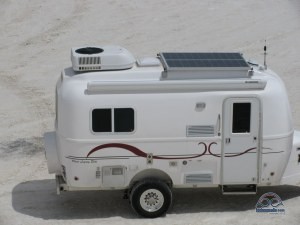
On an RV roof however – efficiency is usually more important than absolute lowest cost. There just isn’t space to add more panels to make up for extra energy needs.
One further note on efficiency… If only 20% of the solar energy is being converted to electricity, where is the rest of that power going?
A lot of it is turning into heat.
Solar cells tend to be black, and they absorb a lot of the excess energy as heat rather than reflecting it away like a white roof would do. This has the potential to make your RV interior warmer, and as that heat builds up the solar cells will become less efficient – producing even less electricity.
For more irony? That may actually necessitate the need for running the air conditioning to offset the interior heat caused by the panels – resulting in resorting to generators or electric hook-ups much sooner than otherwise.
Hard Solar Realities
A lot of people with solar on their RV have no idea just how little power they are actually generating, and they would be shocked if they knew that even on their best days they might be seeing just 80% of the rated power out of their panels – and that only for a few hours each day.
And on cloudy days, a 100W panel may only produce 10W or 20W – barely enough to keep a basic LED light fixture lit.
I sometimes suspect that this may be the reason that so few solar controllers provide a power readout in watts – instead showing just the amps going into the battery. If you have a solar controller that does not display wattage, you can calculate it by multiplying the charge controller output amps by your RV battery voltage. For example – if your charge controller is putting 3.7A into a 12.6V battery, you are generating just 47 watts of power.
On the other hand – nothing beats heading out on a sunny day running errands, and coming back to find your batteries fully charged without ever needing to even think about running a generator.
The goal is to design solar systems that make this possible.
And our goal in this testing project is to help demonstrate some real-world scenarios and results so that RVers are better able to set and manage their expectations.
Stay tuned for the next chapter…
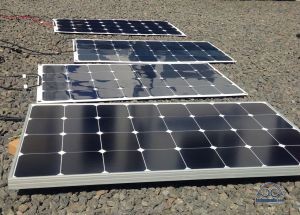
Testing Update: We have added a 100W traditional rigid glass panel from AM Solar to our testing arsenal for comparison purposes.
We aren’t sharing any specific results or conclusions from our testing just yet though – one of the panel manufacturers suspects that we might have received a defective panel and they are rushing us a replacement. We want to give them the benefit of the doubt, and will need to re-run all of our testing once it arrives. And, now that we’re on the coast of Oregon, we have to also wait for a rare sunny day for that!
We hope you will follow along on our ongoing Solar Quest – you will be able to access all of our solar related posts from our new RV solar page.

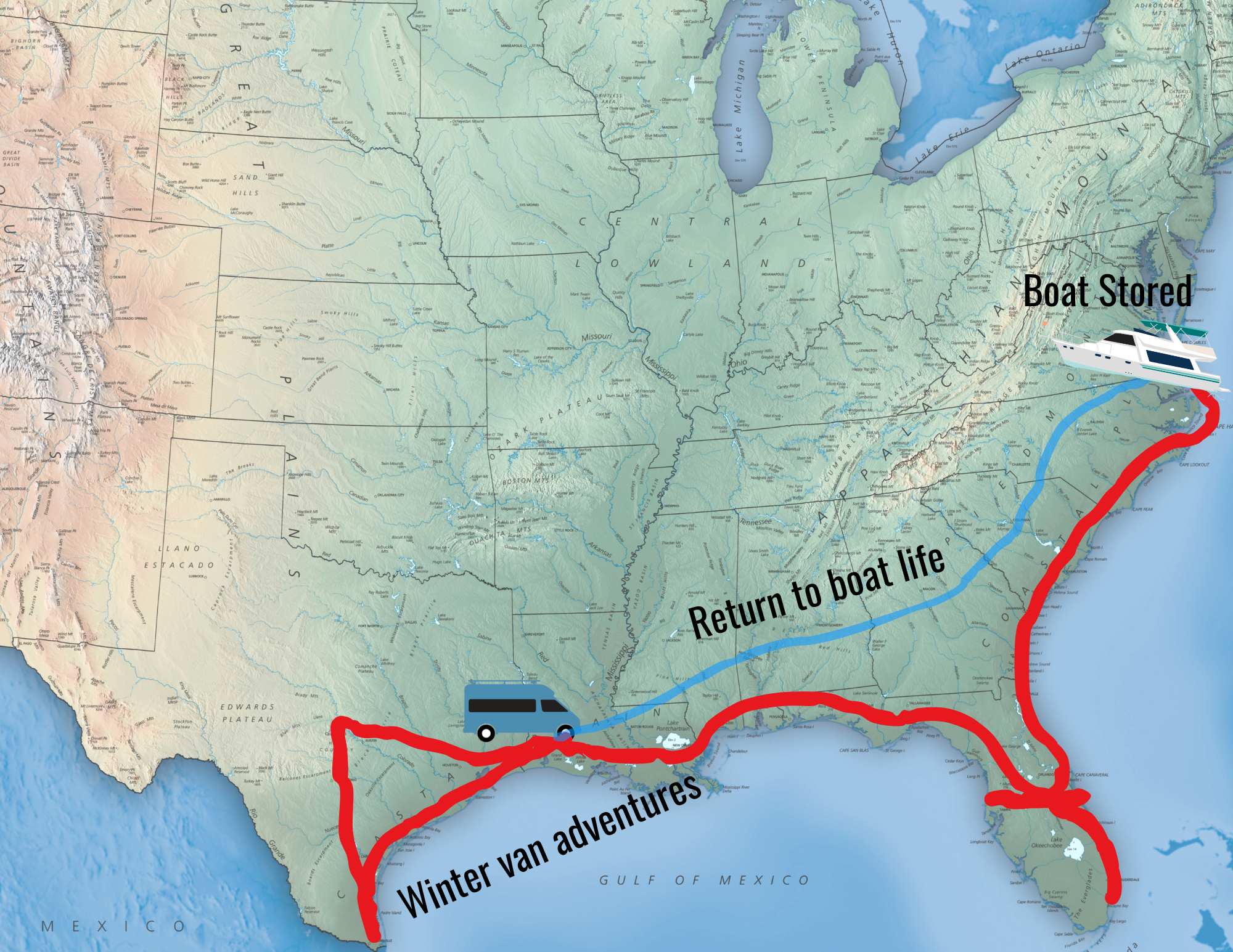
what is output power of individual cell?
Every panel could be different.
To determine the wattage of a cell, take the wattage of the panel and divide it by the number of cells on the panel.
Hi really helpful post. Got one question that people’s opinions seem to differ on. Is higher Open Circuit Voltage (Voc) better in terms of efficiency? (Provided that your MPPT can handle it? (often < 100V)).
Higher voltage is great if you have long wire runs – for example, stretching out 100′ of wire to a ground panel set up in the open sun while you are parked in the shade.
But if wire length and gauge are kept equal – it is hard to say where the sweet spot is. Every MPPT controller seems to be a bit different, so you’ll have to check the documentation and efficiency charts to see if there is a substantial difference between lower and higher panel voltages.
– Chris
Do solar panel need to be raised or can you lay them flat on a caravan roof
Solar panels produce a lot of heat – giving them an air gap increases their efficiency, and reduces heat coming into your RV.
Chris, excellent article and learning tool. I too am a RV’r, ever since 2004, but never thought of being a permanent Nomad! Thanks for the great article and sharing. You helped me understand panels and their ratings.
This is an awesome sharing Chris. Keep going whit it..!!!
No I can’t find prices. Seems one has to ask for a quote…
Spec Sheets are here:
http://www.stellarsolar.net/downloads/SPR-x21-335-345.pdf
http://us.sunpowercorp.com/cs/Satellite?blobcol=urldata&blobheadername1=Content-Type&blobheadername2=Content-Disposition&blobheadervalue1=application%2Fpdf&blobheadervalue2=inline%3B+filename%3DX-Series%2BSupplementary%2BTechnical%2BSpecifications_Arena%2B505915%2BREVA%2B%2528%252805APR%2529%2529.pdf&blobkey=id&blobtable=MungoBlobs&blobwhere=1300286165757&ssbinary=true
Hi Chris & Cherie!
Thank you for your awesome sharing on so many great things for us that love life on the road. I’ve been checking in on you now and again here from Europe
I hope I’m not off topic here, but what about the Sunpower X21 panels? I read somewhere that Sunpower went out of business and the website has changed since I last checked. But aren’t (weren’t) those the post efficient panels available commercially? Interesting for RV use or not?
I don’t believe that SunPower has gone out of business – and in fact it seems that a lot of the RV-optimized panels are actually based upon SunPower cells.
The flexible panels from GoPower and Grape are both using SunPower cells I believe – and they are indeed very efficient per square meter.
You can recognize SunPower cells by the solid black fronts with no lines across them. I do not know of any other cell that would look the same.
– Chris
OK. Great! Thanx. Still… the Sunpower X21 panel looks like it has comparably larger numbers on the spec sheet Are they much more expensive? What are the downsides in your opinion about the X21 panels?
Are they much more expensive? What are the downsides in your opinion about the X21 panels?
Not sure what numbers you are referring to… The X21 is not a flexible panel, so it hasn’t been on my short-list to look closely at, and I haven’t tracked down any prices on it either. Have you?
– Chris
Chris, One of THE best written explanations of RV solar power I’ve read and better yet – UNDERSTOOD! Not ever having solar on my RVs but thinking that in the future I will likely look into it, these articles are something I know I will come back to.
Thanks Sherry — I’ve still got a lot to cover, but I am hoping to strike a balance between depth and readability.
Chris,
I don’t recall how much you have touched on these related points (that I’m sure you are aware of ) in your articles, but….
1) I have been told that Lithium batteries charge much faster than AGMs, especially the last 20%.
2) Charging a trailer’s lithium battery generally needs a separate high capacity wire (I’ll be using 2awg) going from the tow vehicle’s battery isolator (since you can’t connect both AGM and Lithiums) to the trailer’s Lithium battery using a similarly-rated quick disconnect connector. Trying to charge using the standard 10 or 12awg wire in your 7-pin will barely push any juice thru to the battery.
3) Many tow vehicle’s alternators barely put out enough amps for the vehicle itself much less for charging a trailer battery if you have big speakers, a winch, or other loads from upgrades. Upgrading to a high output alternator is something I’m considering, especially one with high output (100 amps +) at idle speeds. Or, apparently you can add a 2nd alternator instead…but still need high output while idling if you want to charge the battery for 30-45 minutes or so during boondocking.
Just thought I’d pass that on.
Karl
Hi Karl –
We are well aware of all the advantages of having lithium batteries – we’ve been using them for over three years now. You can read all our posts on the topic here:
https://www.technomadia.com/lithium/
And indeed – lithiums excel at that final 20%, which makes them a great match for solar.
As for charging a trailer via a tow vehicle alternator… That is indeed a challenge to do quickly, in large part because the wire run is so long. We used to have this problem back in our small trailer days. Now with our bus we have a huge 220A alternator, and a relatively short run of 4 gauge wire between the alternator and the batteries. This makes for much quicker charging!
– Chris
Sorry, I didn’t mean to imply you were lacking any knowledge about Lithiums. In know that you have tremendous experience in this area. I was just passing on to your readers a few things I have recently learned that were not terribly obvious at first glance…and things that some alleged experts had advised me on incorrectly.
Thanks again for the great wealth of information that you share.
No worries Karl – and thanks for the reminder that I need to make sure to recap some of the lithium advantages when I get to the part in this series of posts focusing on charge controllers.
To answer Karl’s question, the best app that I know of for solar azimuth and altitude is the Photographer’s Ephemeris. It will also do stuff like tell you when the sun will appear from behind a hill. It will get locations from gps, direct entry or dragging pins on a map/satellite photo. You can figure out when the sun will shine a particular spot like a campsite and how high it will be at that time. Too many other features to list here and definitely overkill for solar. It’s designed to help a hard core photographer/geek plan outdoor shoots. On the other hand, if you like cool tech stuff it’s fun to play with.
Jenny,
That may be exactly what I need. Thanks so much!
Karl
Nothing specific to add, but am interested in reading other comments.
Wanderman is testing a set of solar panels on his RV. You might want to contact him. We met you at Oshkosh Air Show couple years ago. Have been following your blogs. Great work. We are currently in Bend, OR area.
I’ve swapped notes with Wanderman in the past, but it has been a while. If I remember right, his first flexible panels started to fail prematurely – and he has now trying again with a different supplier. I will have to drop him a line and chaco in.
In winter in the SW desert I have seen the output of my tilted solar panels exceed their raiting for a few minutes at a time — but the average for the hour was still less than the rating. At high altitudes and cold temperatures there is more chance of this, and I have heard of controllers being damaged by the output of panels in such conditions. (High voltage panels and not enogh margin between the VOC rating of the panels and the maximum input of the controller.)
Indeed – many solar controllers can not handle being over-powered.
A few can however – making it possible to design a solar charging system around average power output, without worrying about rare peaks. Our Victron charge controllers have this as a feature, and I believe some Morningstar controllers are capable of handling an overload without damage as well.
Indeed, when I talked to Morningstar about my “45A” charge controller, they assured me that I could in fact wire up just about any amount of panel power and the controller would handle it just fine. The amperage designation identifies the maximum current the controller will ever deliver to the downstream side, not an input limit. This is direct from them, because I was worried that I might blow the controller.
I’ve got 540W of Grape Solar monocrystallines hooked up to the Morningstar controller. Best output seen so far was 380W, but it is hard to care when my batteries have always been recharged by noon on a sunny day (and sufficiently recharged even on rainy, cloudy days). Not too much heat from the controller either, which is good given its intimidating looking heat fins.
Remember to mention MPPT at some point in your write up
Have you run across an Android app that can help you position your solar panels (or position your trailer if your panels are fixed) to maximize your solar input based on your GPS position, time of year, and time of day? An online calculator that can be accessed on a laptop would work too.
Thanks.
I’ve not run across such an app for iOS or Android, but I haven’t looked either.
If anyone has any recommendations – post them here.
Hi Karl,
Unless you’re planning on installing a system which tracks the sun as it moves across the sky, I think your best bet would be to face your panel(s) south and then tilt them based on your latitude and time of year. There’s a simple online app here http://solarelectricityhandbook.com/solar-angle-calculator.html that allows you to enter a city and it tells you the best angle for each month of the year. There’s a pretty good article describing the benefits of tilt here: http://www.solarpaneltilt.com. As this article states, a decent rule of thumb is that the tilt should be equal to your latitude, plus 15 degrees in winter, or minus 15 degrees in summer. (I have not verified the accuracy of the information presented on either of these sites, but they seem legit.) Given that it’s unlikely one could park a vehicle/trailer so the panels face exactly due south, that approximation is probably good enough.
Another thing to consider is that if your panels are behind one another, tilting them will likely result in the one in front casting a shadow on those behind it. This of course results in a very significant reduction in output from the shaded panels. And if they are connected in series, all the panels are affected.
When I do my van conversion next year, I’m actually considering adding some linear actuators to my panels in order to provide the seasonal tilt. Seems like it wouldn’t be all that difficult, and I love to geek out like that. We’ll see.
Great, Pete. Thanks!!
Hey Chris,
Great post. My girlfriend Nikki and I decided to become nomads while on our annual two week camping adventure last month. We always hate when our road trips come to an end and suddenly a light bulb went off: let’s just never stop! Our plan is to hit the road in a van conversion within the next year or so. We’ve been scouring the net for information and people’s experiences for the last couple of weeks (it’s all we can think about these days). I stumbled upon your site yesterday and we’ve been devouring its most-excellent content pretty much non-stop. It’s obvious how much time you and Cherie spend, and we greatly appreciate it.
We’ll be doing the van conversion ourselves and installing solar on the roof, so I’ll be following this series with interest. Being a total geek myself, I plan on tricking it out with the best technology I can afford. Due to the limited area on top of a van, I’ll likely use rigid panels, so I’m glad to see you’ve thrown one into the mix. Based on the photos in your recent posts, it appears that you’re testing the panels on the ground. I’m curious to know if you’ll be elevating the rigid panel somewhat, since that’s likely how it would be mounted on an RV (or van in my case). Might help someone like me to decide whether to go with flexible versus rigid panels. The rigid panels should be more efficient, but they will decrease our gas mileage slightly.
Slightly off topic, I was also psyched to see you used lithium batteries on Zephyr. While researching rv electrical systems I briefly wondered if anyone had used alternative battery technologies, but assumed the answer was no after reading dozens and dozens of blogs and forum posts. Then I found your site and now there’s a good chance I’ll follow your lead. I like living on the bleeding edge.
Looking forward to your next post!
Pete & Nikki
Awesome to have you following along – it is always great to have company out on the bleeding edge.
And yes – when we test with the glass panel, we will experiment with raising it up a bit for airflow.
Cheers!
Chris
Im just wondering how laying panels on the ground can give you real life solar data, I would assume the ground to be 10-25 deg cooler vs an RV roof, this would tend to give you much better results. It would also be a GRAND SLAM – if you would compare the solar output going into Flooded Batteries lets say T105 Golf cart batteries vs your 500 AH Lithium Battery …..my guess is that the solar output would be 50% – 100% higher with Lithium Batteries. In general a panel can only max out power if the battery is hungry to suck in all the power. My understanding is if you have a 300 watt panel attached to a 98% full battery your just gonna get 20-50 watts max output ? Glad to see your doing all the hard work for us RV newbies.
Cheers Jerry
http://overthetopcargotrailer.blogspot.com/
Hi Jerry —
We’ll do the best we can to test on a range of surfaces – a hot asphalt parking lot, gravel, grass. We’ll take some temperature measurements we can compare with roof surfaces too.
As for battery charging… When “bulk charging” via solar, a lithium and a flooded battery will both take all the current the solar charge controller can put out. The huge advantage with lithium comes when charging the final 20% of the battery capacity. Flooded cells drop into a slower absorption charge, wasting more and more solar power the closer they get to being full. Lithium stays in bulk mode almost all the way to being 100% charged.
We’ve covered this advantage in our lithium posts in the past – I’ll make sure to link to it when I write about solar charge controllers.
Chris
Poor transfer efficiencies of lead acid require 20% larger solar installations when compared to LYP lithium storage systems. Lead acid batteries due to their high internal resistance have a transfer efficiency of 72 – 76% compared to 96% transfer efficiency of the LYP battery. A 50W, Solar panel installation can produce 400 whr of energy during an 8 hour period, but only 304 whr of this energy will be stored by lead acid batteries, meanwhile a 40 watt solar panel installation with LYP batteries would store the same amount of energy during an eight hour period.
I have personally found a much larger differance between flooded & lithium , that’s why I recommend you try it. With 660 watts incoming solar & 450 watts going to my window AC connected to flooded batteries the amps from my inverter powering my ac went from 42 amps to over 85 amps within 60 minutes, the flooded batteries were not absorbing the solar. They just created heat – with lithium everything works perfect. Also with Flooded batteries I was getting 2,600 watts max daily – on Lithium I have gotten 4,500 to 5000 watts on many days.
With 1,000 watts in panels I was getting 660 watts max with flooded batteries, using lithium batteries I was getting 750- 800 watts from the exact same panel – only differance was the batteries.
Cheers Jerry
http://overthetopcargotrailer.blogspot.com/
We’ve been running lithium for over 3 years now (https://www.technomadia.com/lithium) .. no need to recommend we ‘try it’, we’re already well on onboard We’ll be doing all of our testing agains our LFP setup. Based on the data, we’ve felt LFP is an ideal battery setup for solar, and thus why we invested in it early on.
We’ll be doing all of our testing agains our LFP setup. Based on the data, we’ve felt LFP is an ideal battery setup for solar, and thus why we invested in it early on.
Greetings and thanks so much for your great website and all the knowledge you’re sharing. I am looking at solar for my first trailer and wonder why I don’t read more about portable panel options (mounted remotely on the ground and not permanently on the roof). It seems like this set-up would solve many of the problems associated with roof mount panels, like overheating, improper positioning, shading issues, limited wattage for smaller rigs, being forced to park in the sun and not the shade…. Only downside I can think of is the security issue of the panels being vulnerable to theft. I am also suspicious of the quality of the charge controllers that most portable systems come with. Also since the controllers are located on the panels, this creates a long wire run to the batteries (voltage drop). I’ve read that this is not a desirable situation. I would love to find a portable system w/o the controller and find a marine grade “plug-in” that could be mounted permanently to the trailer. Plug in the panels, and have my controller on the other side next to my battery bank. Am I missing something? Thanks and happy traveling!!
Dave
Dave – Your thinking is pretty spot on, both on the advantages and disadvantages of portable panels.
The one downside you also missed is time in use… Roof mounted panels work all day, every day – even while you are underway. Portably panels require setup time, and are never going to be particularly practical to deploy when stopping someplace for just a day or two.
I think ultimately it might make sense to do both – and I plan to write about the reasons later in this series as I research the tradeoffs more.
I have a 15′ fiberglass trailer, so limited roof space. I installed a 100 watt panel on the roof wired into 2 y cables in the closet and then into charge controller. The other connector on each y cable is wired through the floor and terminated in MC4 connectors. To connect my additional 100 watt portable panel, I just connect it to the 2 MC4 connectors. Setup time is less than 5 minutes.
That is indeed a great setup. I think a hybrid roof/external setup is a great way to go, even if you have ample roof space.
With all the room on your roof y r u useing a 100w panel by the way Hi guys
Your pluged in to the parks FREE grid remember frees good
Knowing your useing LI battery’s you can kick lots of amp. Watts , to get your 14.8v
But the down sides how low can you draw down with the LI ,s Battery’s 11.2 ????
And if when not in use on your best day,, how fast do you expert to go to (mpw) bulk or (mppt) float
You already have a MPPT controller (amps watts output unknow ) whats wrong with looking to 24v panels ??
12v or 24v the cost is darn near the same,, mine were a buck a watt,, now there’s no way I would ever use as much power output as you do, so I don’t understand the 12v thingy
1 panel 230w 6 days in the PNW with full cloud low over cast and full float at 3pm, instead of 12noon
I got friendly dealer in Gainsville for panels we can slip one in your Moms inlaws luggage if you like
J Y D
Hi Ed –
Two 12V panels in series does put out 24V, and that is actually how we have been doing the bulk of our testing.
I’ll certainly be writing a lot about panel voltages and options when I talk more about MPPT controllers.
As for using native 24V panels… I don’t know of any flexible 24V options. Do you? If there were any good options, we would definitely look closely at them.
JYD,
– Chris
Nice write up, Chris. Well thought out and written in layman’s terms for easy understanding. I’ve been looking at solar on our RV for several years now and your test will help us decide what are the best panels for our planned system.
Thank you so much for taking on this test and sharing the results with us! :c)
Excellent article! Very well written and easily understood. You’re good, you! You! You’re good!
In order to follow the angle of the sun, some sort of bracket or mechanism must be designed for ease of use. Every watt counts.
Have you ever seen any good RV solar mounts that make tilting super easy?
I’ve hardly ever seen anyone actually taking advantage of tilting solar panel mounts on an RV, even on the rigs that have the capability. They require climbing on the roof, usually can’t be left tilted if there is a potential for strong wind, and they limit the angles which you can park your RV too.
Every watt counts – but often convenience is even more important.
The only place where tilting really makes sense is extended boondocking in the southwest over the winter. The sun is low in the sky, and tilting really can make a lot of difference.
Well those are some pretty depressing facts. I may find I liked being less-educated when this testing is done Still, I know we want solar power, and to be as free from generator-dependence as possible, so I’m very much looking forward to the results.
Still, I know we want solar power, and to be as free from generator-dependence as possible, so I’m very much looking forward to the results. )
)
Given that your testing is “un-installed” I’m hoping for information on optimum wiring, inverters, etc., as well. Too much?
Thanks Chris (my head didn’t even explode….although there were some strong vibrations in a few places where the math was
We’ve written about inverters in the past, so you should be able to find the posts in the archives here. I plan to write some about solar charge controllers in this series, and some tips on wiring too. But this will not be a comprehensive “how to install” tutorial.
Jack Mayer’s RV Electrical and Solar is a great resource to check out too.
Glad I struck the right level – I aim for strong vibrations…
Chris & Cherie,
I really enjoy your articles and videos. I also enjoy reading the technical data and often have numerous tabs open comparing things. I am new to RV’ing and just recently started following you. I am following your solar research with great interest. The information you present has helped me a lot. Thank you and please keep up the work you are doing. It is greatly appreciated.
Greg